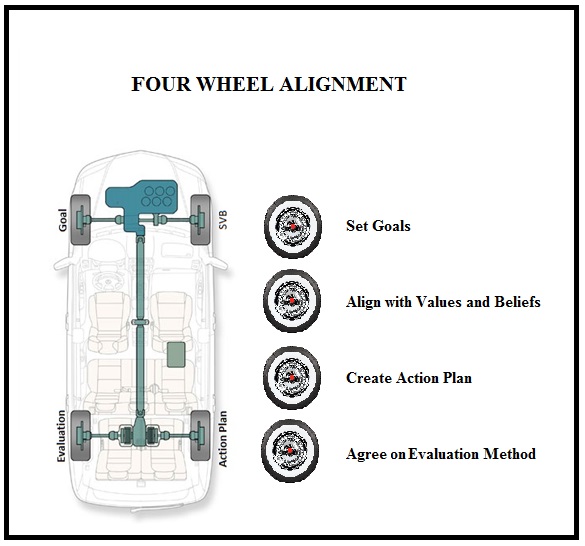The End
This could have been the end of the presentation; however, considering reader’s engagement and the writer’s desire to further explore the prior statement that read each wheel is connected both ways with the other three, below are six sets of visions. They are opinions, speculations, arrangement of subjective logic – attempts to describe the relationships between the four wheels of the model. First, the relationships will be presented schematically then, the descriptions will follow.
II. Getting the full picture
The schematic representation of two-way relationship that connects each wheel with the other three is depicted below.
Now we will examine each relationship in more detail to see how misalignment of each wheel will affect the overall direction of movement along the axis of Being, and / or of Doing.
III. Relationships between the wheels
Meaning / Significance is the relationship between the wheels of Goal and Set of Values and Beliefs. The goal may be well defined, but if it does not correspond to the underlying beliefs or to the core values, the goal may be missed or, reaching the goal is not going bring meaning or happiness. On the other side, the more goals that are gone unreached, the stronger the negative beliefs will grow and, ultimately, the more values will start turning from positive to negative. Correct alignment between the two wheels is essential for creating strong desires and motivations. The particulars of SVB will influence the details of the action plan.
Justification. When I think about the expression “The ends justify the means”, I think about a simple example of making a large sum of money (the end). It can either be earned or stolen (means). The end result will be the same (providing the thief does not get caught), but the action plans (means) will be quite different and is influenced by the two, very different SVBs. When we look at the efficiency of the actions, whether legal or not, the stronger the SVB, the stronger will be the desire to perform one’s best. On the other hand, strong actions are justified by SVB. In the absence of actions, SVB becomes just a list of ideals.
Information. Action Plan and Evaluation wheels constantly exchange information with each other. The Action Plan sends the instructions and receives the progress report back. A good example is a workout routine. A good workout has an action plan that lists exercises, sets, and reps. The Evaluation wheel receives the information and measures the progress in predetermined units of size, weight, fitness, strength, looks, etc. If a client stops following the workout list, or stop measuring progress on regular basis, there is a breakdown of the entire coaching model. Refer back to figure 1. Imagine that the rear axle is broken. You can still steer, but the car won’t get far.
Distance. Is a distance between the original goal and the point where the client is currently. If, with time, the client is not getting any closer to the goal, all four wheels may be a suspect.
The know-how is communication language between the Goal and Action Plan. Without that piece of intelligence (either internally derived from prior experiences, or newly learned) Action Plan cannot answer the question of “what to do”. Large goals are achieved by breaking them down in smaller pieces or intervals, and creating action plan for each interval. Once the smaller goal is reached, the Action Plan send back a “message” to the Goal, requesting a new set of instructions for achieving the next goal.
Catch 22, compared to other relationships, may not be as obvious or as strong. Yet, the SVB influences the selection of evaluation methods through Action Plan wheel. When Evaluation undergoes frequent changes over a longer period of time, it influences the changes in SVB. For example, in order to feel more confident (Goal), a person may keep on changing evaluation methods of his or her confidence by changing the desired outcomes. Eventually, these changes will influence certain beliefs about the significance of the outcomes. New SVB, through Action Plan will bring Evaluation in better alignment with the rest of the wheels of the model.


